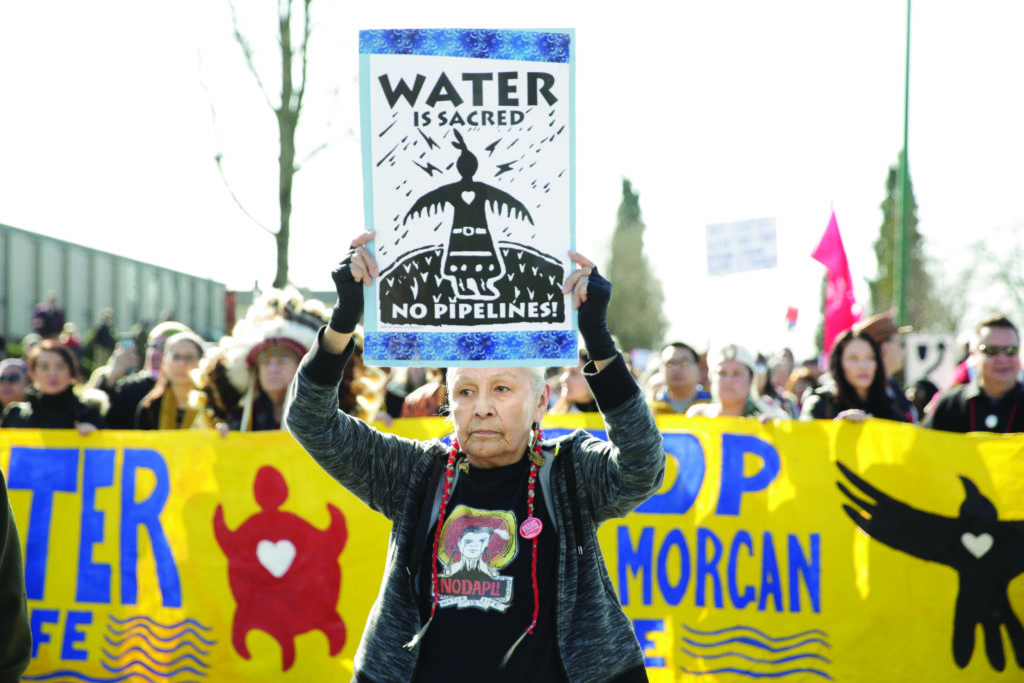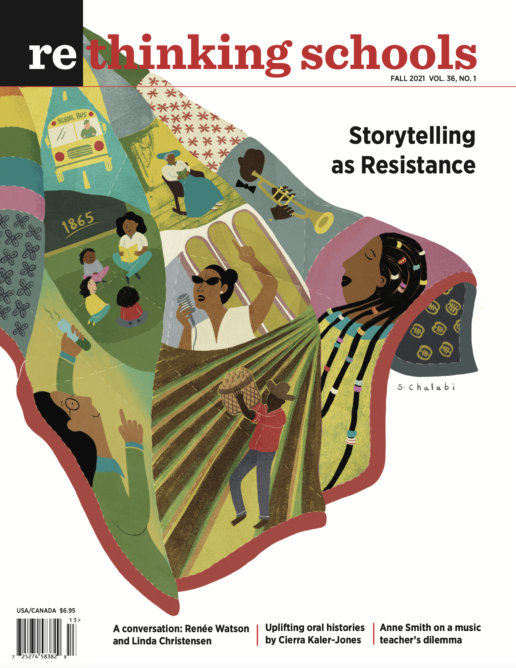To Teach About the Climate Emergency, Let’s Learn from the Movement to Abolish Slavery
Earth, Justice, and Our Classrooms

“A code red for humanity.”
That’s what U.N. Secretary-General António Guterres called the new report from the Intergovernmental Panel on Climate Change (IPCC) Working Group 1. As Guterres said: “The alarm bells are deafening, and the evidence is irrefutable: Greenhouse gas emissions from fossil fuel burning and deforestation are choking our planet and putting billions of people at immediate risk.”
The temptation is for teachers to spend our time cataloging the dire consequences of climate chaos — and its causes — equipping students to grasp the enormity of what is unfolding around us. Yes, we need to do that. And we need to do it better. But the key curricular conversation we need to initiate with students is: What can we do about it? And we need to raise this question with a no-bullshit urgency.
In the same week of the IPCC report, climate justice activist Jessica Reznicek entered Federal Correctional Institution-Waseca in Minnesota to begin serving an eight-year sentence for damaging pieces of the Dakota Access Pipeline in 2016 and 2017. Reznicek and fellow activist Ruby Montoya set fire to heavy machinery used to construct the pipeline. Reznicek and Montoya moved along the pipeline, damaging valves — which, according to Democracy Now!, delayed pipeline construction for weeks. They are climate heroes.
It’s not a teacher’s job to recruit fossil fuel saboteurs. However, what Reznicek and Montoya know — and what we want our students to grasp as well — is that by pursuing its profit-first mission, the fossil fuel industry is destroying the conditions for life on Earth. Naomi Klein puts it succinctly: “The oil companies’ business plan is to wreck the planet.” Given the central role they have played in creating and exacerbating the climate emergency, the fossil fuel enterprise is an odious, illegitimate form of property. Our teaching about climate justice needs to be built on that truth.
I’ve been reading Andreas Malm’s passionate — and provocatively titled — book, How to Blow Up a Pipeline. Malm describes the vantage point of the lords of the fossil fuel industry:
They are not perturbed by the smell from the blazing trees. They do not worry at the sight of islands sinking; they do not run from the roar of the approaching hurricanes; their fingers never need to touch the stalks from withered harvests; their mouths do not become sticky and dry after a day with nothing to drink. To appeal to their reason and common sense would evidently be futile. Their commitment to the endless accumulation of capital wins out every time.
The endless accumulation of capital. There has never been a moment in world history when the survival of humanity and life on Earth collided so decisively with the imperatives of the capitalist system.
But students can learn from a moment in our history when a social movement confronted and defeated another odious form of “property”: the enslavement of human beings. The abolition movement had no respect whatsoever for enslavers’ legal right to own and control their property. Indeed, the movement called for the immediate expropriation of the largest industry in the United States. Yes, industry: On the eve of the Civil War, there was more money invested in the enslavement of human beings than in all the banks, railroads, and factories combined.
By the 1850s, the institution of slavery was supported by the Fugitive Slave Act, which provided a diabolical legal architecture to prevent enslaved people from seeking freedom: Bystanders in every state could be drafted to recapture enslaved people; enslavers could easily make claims against alleged escapees, and no Black person could testify in court in their own defense; and anyone “directly or indirectly” helping someone to escape slavery could be arrested and imprisoned. (In textbooks, this hideous collection of measures is politely referred to as part of the Compromise of 1850.) The entire state apparatus was at the service of the slaveocracy. And in 1857, in Dred Scott v. Sandford, the U.S. Supreme Court gave its blessing to slavery, and white supremacy more broadly, with Chief Justice Roger Taney offering his infamous assurance that Black people were “altogether unfit to associate with the white race, either in social or political relations; and so far inferior, that they had no rights which the white man was bound to respect . . .”
Abolitionists understood they owed no allegiance to a legal system that opposed humanity.
Sure, lots of the abolitionists’ work was legal. They formed above-ground antislavery organizations, published newspapers, preached sermons, held meetings, wrote books, passed resolutions. They even raised money to purchase people from their enslavers.
But they also defied the Fugitive Slave Act, “stealing” people from their supposed owners, transporting and harboring people who seized their own freedom, defending freedom-seekers with armed vigilance committees, and forcibly preventing people’s re-enslavement. The most popular novel of the 19th century, Uncle Tom’s Cabin, was a paean to the Underground Railroad, and (despite its stereotypes) celebrated acts of armed resistance by the enslaved. Some, like John Brown and his comrades, went so far as to try to foment rebellion.
And, of course, the enslaved themselves were the beating heart of the abolition movement: In countless ways — some covert, some public — their resistance was the ongoing source of moral authority that undermined the justifications invented to legitimate people’s enslavement.
A climate justice curriculum should include a careful study of the abolition movement. (See the Rethinking Schools book Teaching a People’s History of Abolition and the Civil War.) The antidote to students’ despair and resignation about the climate crisis is not necessarily for them to study the crisis more intensively. It’s the history of radical activism we need to build into our curriculum — radical as in going to the root of a problem and letting morality rather than legality be our guide.
Of course, other social movements also have lots to offer about how to effect change, but the abolition movement was arguably the most audacious movement in U.S. history. Not only did it call into question the legitimacy of a bedrock U.S. institution, and urge the expropriation without compensation of the “means of production” of the most powerful segment of the U.S. ruling classes, it did so in the face of increasingly pessimistic circumstances. In 1833, the American Anti-Slavery Society was founded. By 1860, after almost 30 years of organized antislavery activism, twice as many people lived in slavery, more U.S. territory was dedicated to slavery, enslavers possessed more wealth, and as mentioned, the federal government’s commitment to slavery was more solid than ever.
As students confront climate catastrophe, the abolition movement teaches that fundamental social change is possible, that change can come rapidly, decisively, and unpredictably. And the abolition movement teaches that we needn’t be “reasonable”; we should not allow the people who are the source of a problem to dictate how we organize to address that problem. Andreas Malm echoes a key insight of the abolition movement: “The ruling classes will not really be talked into action. They are not amenable to persuasion; the louder the sirens wail, the more material they rush to the fire, and so it is evident that change will have to be forced upon them.” There is nothing sacred about laws that uphold injustice; as Howard Zinn asked rhetorically, “Are we not more obligated to achieve justice than to obey the law?”
In our curriculum, let’s connect students with people like Jessica Reznicek and Ruby Montoya, whose activism is in the spirit of the abolition movement. In “Teaching Climate Disobedience,” Ursula Wolfe-Rocca describes a lesson about the activists disrupting Enbridge’s Line 3 pipeline in Minnesota, like the Ojibwe lawyer and organizer Tara Houska, who was also arrested at Standing Rock resisting the Dakota Access Pipeline; and Ernesto Burbank, a citizen of the Navajo (Diné) Nation, who chained himself with others to the security gate at a Wells Fargo bank in Duluth, Minnesota, demanding that Wells Fargo divest from all fossil fuels, especially Enbridge Energy.
In the role play “Teaching Blockadia: How the Movement Against Fossil Fuels Is Changing the World,” posted at the Zinn Education Project, students encounter people from around the world who are imaginatively resisting and creating alternatives to the fossil fuel industry: anti-coal activists in Haimen, China, who organized 30,000 residents to block a highway to protest a new coal plant; Swarthmore Mountain Justice, students at Swarthmore College in Pennsylvania who built a campaign to get the college to divest from fossil fuel investments in solidarity with activists in Appalachia trying to stop mountaintop removal coal mining; Germany’s Our Hamburg, Our Grid, which organized to democratize the city’s energy system and take it away from pro-fossil fuel corporations; and residents in the Beaver Lake Cree Nation in Alberta, Canada, who have battled the vast network of open-pit mines and oil refineries that make up the Alberta tar sands, the largest industrial project in the world.
There is a festival of climate activists — inheritors of the abolitionist tradition — waiting to meet our students.
The climate justice resolution passed unanimously by the school board in Portland, Oregon, in 2016, says that all students should “come to see themselves as activists and leaders for social and environmental justice.” A good place to start is to connect students with radical activists and movements — past and present — that respect life more than property and authority.

